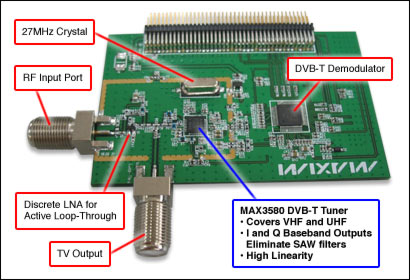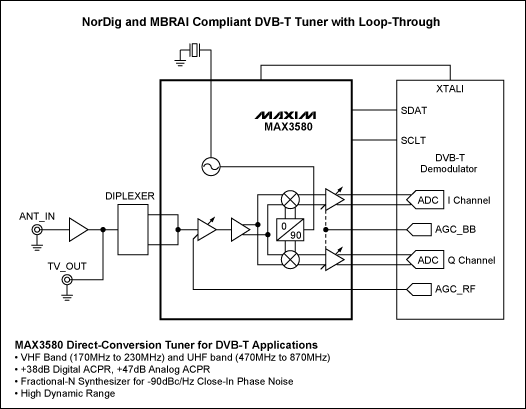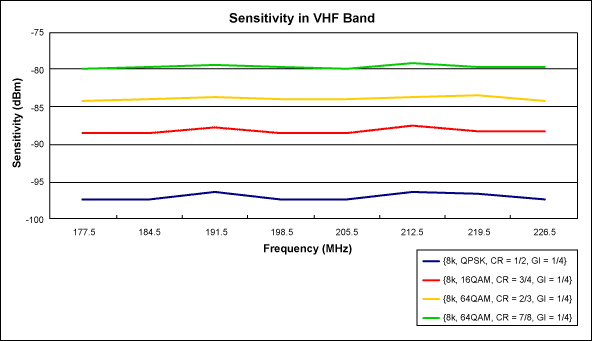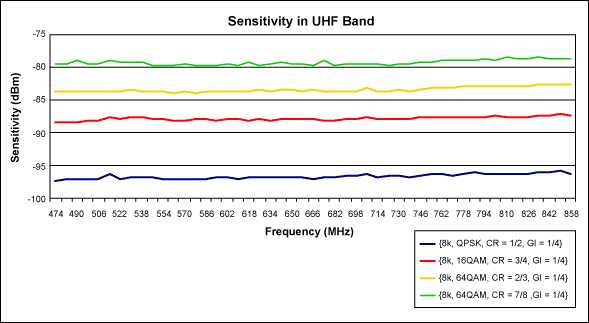

MAX3580 DVB-T Reference Design
IC应用电路图
505人已加入
描述
MAX3580 DVB-T Reference Design
Abstract: The MAX3580 DVB-T reference design meets NorDig and MBRAI requirements. This NIM design includes the MAX3580 direct-conversion tuner and a COFDM DVB-T demodulator. A discrete, active loop-through with low power consumption and low cost is included. 
Figure 1. The reference design for the NorDig and MBRAI DVB-T tuner features the MAX3580. 
Figure 2. System block diagram.
| Lab Measurements |

Figure 3. Data shows that there is at least 2dB margin to NorDig 1.0.2 in the VHF band.

Figure 4. Here the data shows that there is 3.5dB to about 5dB margin to NorDig 1.0.2 in the UHF band.
| NorDig Compliance |
| Parameter | Conditions | Measured | NorDig | Units |
| Operating Frequency Range | VHF-III Band: 170MHz to 230MHz | – | ||
| UHF Band: 470MHz to 870MHz | – | |||
| Sensitivity, Gaussian Channel (VHF-III Band) |
QPSK, 8k, CR = 1/2, GI = 1/4 | -97.3 | -94.6 | dBm |
| 16QAM, 8k, CR = 3/4, GI = 1/4 | -88.5 | -85.1 | ||
| 64QAM, 8k, CR = 7/8, GI = 1/4 | -79.6 | -77.2 | ||
| Sensitivity, Gaussian Channel (UHF Band) |
QPSK, 8k, CR = 1/2, GI = 1/4 | -96.6 | -92.1 | dBm |
| 16QAM, 8k, CR = 3/4, GI = 1/4 | -87.9 | -82.6 | ||
| 64QAM, 8k, CR = 7/8, GI = 1/4 | -79.6 | -74.7 | ||
| Maximum Input, Gaussian Channel (VHF-III Band) |
64-QAM, 8k, CR = 2/3, GI = 1/8 | > 0 | -35 | dBm |
| 64-QAM, 8k, CR = 2/3, GI = 1/4 | > 0 | -35 | ||
| 64-QAM, 8k, CR = 3/4, GI = 1/8 | > 0 | -35 | ||
| Maximum Input, Gaussian Channel (UHF Band) |
64-QAM, 8k, CR = 2/3, GI = 1/8 | > 0 | -35 | dBm |
| 64-QAM, 8k, CR = 2/3, GI = 1/4 | > 0 | -35 | ||
| 64-QAM, 8k, CR = 3/4, GI = 1/8 | > 0 | -35 | ||
| Adjacent Channel Selectivity | N+1 DVB-T adjacent channel | 47 | ≥ 28 | dBc |
| N-1 DVB-T adjacent channel | 45 | |||
| N+2 DVB-T adjacent channel | 47.8 | ≥ 38 | ||
| N-2 DVB-T adjacent channel | 46 |
| MBRAI Compliance |
| Case | Category | Measure | MBRAI | Units | |
| Selectivity, S1 Pattern | N+1 | Category a, b1 | 48 | 37 | dBc |
| N+1 | Category b2, c | 45 | 37 | dBc | |
| N-1 | Category a, b1 | 54 | 37 | dBc | |
| N-1 | Category b2, c | 51 | 37 | dBc | |
| N+2 | Category a, b1 | 47 | 37 | dBc | |
| N+2 | Category b2, c | 55 | 37 | dBc | |
| N-2 | Category a, b1 | 45 | 37 | dBc | |
| N-2 | Category b2, c | 58 | 37 | dBc | |
| Selectivity, S2 Pattern | N+1 | Category a, b1 and b2, c | 39 | 29 | dBc |
| N-1 | Category a, b1 and b2, c | 38 | 29 | dBc | |
| N+2 | Category a, b1 | 43 | 40 | dBc | |
| N+2 | Category b2, c | 45 | 40 | dBc | |
| N-2 | Category a, b1 | 42 | 40 | dBc | |
| N-2 | Category b2, c | 44 | 40 | dBc | |
| Linearity L1 | – | Category a, b1 | 45.5 | 45 | dBc |
| – | Category b2, c | 47 | 45 | dBc | |
| Linearity L2 | – | Category a, b1 | 45.2 | 45 | dBc |
| – | Category b2, c | 47 | 45 | dBc | |
| Linearity L3 | – | Category a, b1 | 40.7 | 40 | dBc |
| – | Category b2, c | 42 | 40 | dBc |
| Sensitivity Details for all Modes |
Seven Channels are selected to test the sensitivity for all DVB-T modes.
| VHF | UHF | |||||||
| Frequency (MHz) | 177.5 | 226.5 | 474 | 570 | 674 | 770 | 858 | |
| QPSK, 8k, CR = 1/2, GI = 1/4 | Sensitivity (dBm) | -97.3 | -97.3 | -97.2 | -97.1 | -96.7 | -96.5 | -96.2 |
| Max-Input (dBm) | > 0 | > 0 | > 0 | > 0 | > 0 | > 0 | > 0 | |
| QPSK, 8k, CR = 2/3, GI = 1/4 | Sensitivity (dBm) | -95.9 | -95.7 | -95.7 | -95.6 | -95.3 | -94.9 | -94.8 |
| QPSK, 8k, CR = 3/4, GI = 1/4 | Sensitivity (dBm) | -94.8 | -94.8 | -94.7 | -94.6 | -94.5 | -94.1 | -94 |
| QPSK, 8k, CR = 5/6, GI = 1/4 | Sensitivity (dBm) | -93.8 | -93.7 | -93.6 | -93.6 | -93.3 | -93 | -92.8 |
| QPSK, 8k, CR = 7/8, GI = 1/4 | Sensitivity (dBm) | -93.3 | -93.1 | -93.1 | -92.7 | -92.7 | -92.4 | -92.2 |
| 16QAM, 8k, CR = 1/2, GI = 1/4 | Sensitivity (dBm) | -91.7 | -91.7 | -91.5 | -91.5 | -91.4 | -90.9 | -90.7 |
| 16QAM, 8k, CR = 2/3, GI = 1/4 | Sensitivity (dBm) | -89.8 | -89.7 | -89.5 | -89.5 | -89.3 | -88.9 | -88.8 |
| 16QAM, 8k, CR = 3/4, GI = 1/4 | Sensitivity (dBm) | -88.6 | -88.3 | -88.4 | -88.1 | -88.1 | -87.5 | -87.3 |
| 16QAM, 8k, CR = 5/6, GI = 1/4 | Sensitivity (dBm) | -87.1 | -87 | -87 | -86.9 | -86.9 | -86.4 | -86.3 |
| 16QAM, 8k, CR = 7/8, GI = 1/4 | Sensitivity (dBm) | -86.4 | -85.7 | -86.1 | -85.9 | -85.7 | -85.4 | -85.6 |
| 64QAM, 8k, CR = 1/2, GI = 1/4 | Sensitivity (dBm) | -87 | -86.9 | -86.9 | -86.6 | -86.7 | -86.2 | -85.9 |
| 64QAM, 8k, CR = 2/3, GI = 1/4 | Sensitivity (dBm) | -84.1 | -84.1 | -83.8 | -83.8 | -83.7 | -83.3 | -83.2 |
| 64QAM, 8k, CR = 3/4, GI = 1/4 | Sensitivity (dBm) | -82.5 | -82.2 | -82.3 | -82.4 | -81.8 | -81.5 | -81.4 |
| 64QAM, 8k, CR = 5/6, GI = 1/4 | Sensitivity (dBm) | -80.9 | -80.9 | -80.7 | -80.7 | -80.4 | -80.2 | -79.8 |
| 64QAM, 8k, CR = 7/8, GI = 1/4 | Sensitivity (dBm) | -79.9 | -79.7 | -79.5 | -79.5 | -79 | -78.9 | -78.8 |
| Max-Input (dBm) | -2 | -0.2 | > 0 | > 0 | > 0 | > 0 | > 0 | |
| Supply Current |
Test conditions for supply current measurements include 75Ω terminations on RF input and TV output, active working mode, and system tuned to channel 69 (858MHz).
| Parameter | Conditions | Measured | Units |
| 5V LNA Supply Current | 12 | mA | |
| 5V for Tuner and LNA* | {8k, QPSK, CR = 1/2, GI = 1/4} | 196 | mA |
| {8k, 64QAM, CR = 7/8, GI = 1/4} | 196 | mA | |
| 3.3V Digital Supply Current for Demodulator | {8k, QPSK, CR = 1/2, GI = 1/4} | 8 | mA |
| {8k, 64QAM, CR = 7/8, GI = 1/4} | 10 | mA | |
| 2.5V Analog Supply Current for Demodulator | {8k, QPSK, CR = 1/2, GI = 1/4} | 36 | mA |
| {8k, 64QAM, CR = 7/8, GI = 1/4} | 36 | mA | |
| 1.0V Digital Supply Current for Demodulator | {8k, QPSK, CR = 1/2, GI = 1/4} | 90 | mA |
| {8k, 64QAM, CR = 7/8, GI = 1/4} | 92 | mA | |
| 1.0V Analog Supply Current for Demodulator | {8k, QPSK, CR = 1/2, GI = 1/4} | 3 | mA |
| {8k, 64QAM, CR = 7/8, GI = 1/4} | 3 | mA |
| Detailed Description |
This DVB-T receiver reference design is NorDig 1.0.2 and MBRAI compliant. It is intended for terrestrial set-top box applications and has a NIM form factor. The reference design covers the VHF-III band (170MHz to 230MHz) and UHF band (470MHz to 870MHz) and interfaces with a socket board for testing system performance.
The reference design includes:
- A discrete LNA to realize an active loop-through. The loop-through has 14dB gain and less than 3.5dB noise figure, with 60mW of power consumption.
- A MAX3580 fully integrated silicon tuner, which includes an LNA, RF and IF VGAs, mixer and lowpass filtering in the baseband stages. The tuner operates from a single 3.3V power supply. Only a small number of passive components are needed to form a complete DVB-T RF front-end solution.
- A DVB-T/H-compliant demodulator that features the full DVB-T and DVB-H standards framing structure, channel coding, and demodulation.
声明:本文内容及配图由入驻作者撰写或者入驻合作网站授权转载。文章观点仅代表作者本人,不代表电子发烧友网立场。文章及其配图仅供工程师学习之用,如有内容侵权或者其他违规问题,请联系本站处理。
举报投诉
-
用于MAX3580的前端双工滤波器2023-06-12 1346
-
MAX3580 DVB-T调谐器的应用考虑2023-01-13 1878
-
直接变频DVBT调谐器MAX3580相关资料分享2021-04-15 903
-
基于前端双工滤波器的MAX3580应用2019-07-04 1189
-
基于MAX3580输入端的双工滤波器的设计2017-11-25 1663
-
MAX3580的前端双工滤波器2011-05-16 879
-
MAX2136 ISDB-T/DVB-T低IF调谐器2010-02-21 1242
-
MAX3580 直接变频TV调谐器2010-01-10 993
-
DVB-T学习资料2008-10-20 796
-
DVB-T Receiver Reference Desig2008-10-01 2183
-
MAX3541 DVB-T/PAL Tuner2008-08-18 2630
-
DVB-T技术手册2008-08-05 1032
-
dvb-t是什么意思2008-02-26 4680
全部0条评论

快来发表一下你的评论吧 !

